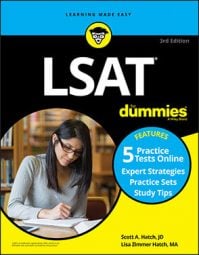Some LSAT test-takers find that an alternative approach to reading questions saves them time and helps them focus on the relevant details of each reading passage. You may want to try this approach to discover whether it works well for you.
Instead of giving a reading passage a once-through skim before you tackle the questions, jump into the questions first. This strategy feels uncomfortable at first, so practice on several passages before you decide whether it works for you. To apply the approach successfully, follow these steps:
Choose the question you think will be easiest to answer first.
You won’t answer the questions in order, so you need a method for picking the best candidate. Start with questions that contain line or paragraph references. They steer you directly to the point in the passage that likely contains clues to the answer. Remember, though, that you almost always have to read more sentences than just the one or two indicated by the line reference.
When you run out of questions with line references, check questions that contain key words that are easy to scan for, such as capitalized or italicized words or specific nouns.
Then tackle the big picture questions.
By the time you’ve considered several other questions, you likely have a general idea of the passage’s purpose or tone. Concentrate on the first and last paragraphs, and especially the last sentences of the passage, to look for clues to main ideas, the author’s attitude, and main point questions.
Save questions that ask for the exception for last because they often require you to read through several of the middle paragraphs to eliminate answer choices.
When you forgo reading the passage before you answer the questions, you have more time to spend on the questions, so use it wisely. Remember these tips:
Questions with verbs such as states, indicates, and claims, as well as those that ask for answers “according to the passage,” seek an answer that is a direct statement or nice paraphrase of information straight out of the passage.
If a question doesn’t provide you with easily scanned-for key words, check the answer choices for easily spotted ideas. Scan the passage for words in the answer choices and eliminate answers that don’t work.
Read the questions and answer choices very carefully. Make sure every part of the answer is true.
Rely on the process of elimination to whittle your way down to the correct answer. Cross out choices you know can’t be true so you can concentrate on narrowing the better-sounding answers.
Don’t spend a lot of time on any one question. If a question appears easy to answer at first but you find it to be more time-consuming than you thought, eliminate wrong choices, move on to another question in the passage set, and mark the question. Return to it after you’ve answered other questions. You’ll approach it again with additional information about the passage.

